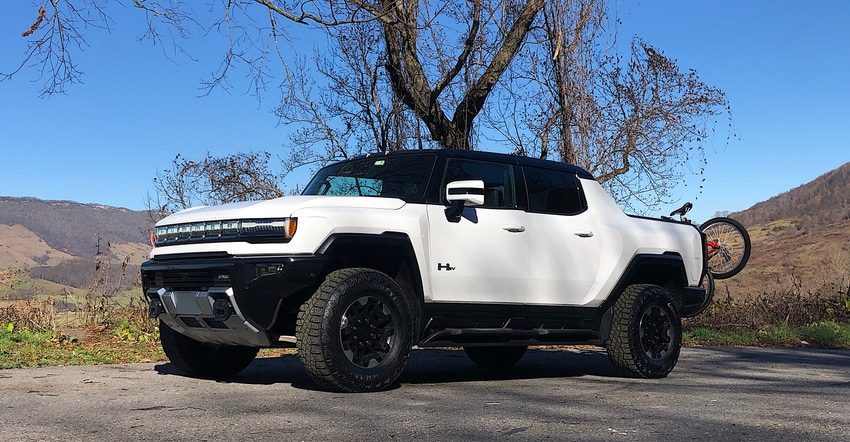A road trip in the Hummer EV highlights the big-battery charging time trap.

The GMC Hummer EV could be seen as the current zenith of EV technology, as its massive 200-kilowatt-hour battery pack provides an EPA-estimated driving range of 350 miles. This made the monster truck the perfect candidate for an EV road trip to probe the practicality of driving normal combustion car trips in an EV.
Along the way, we learned that even with a huge battery there are still accommodations to be made. Actually, because of the huge battery, there are still accommodations to be made. That’s because we found that while a big battery provides a good driving range, it also takes a long time to recharge.
Driving the $108,000 GMC Hummer EV on a road trip, we started with a 75 percent state of charge and a predicted driving range of 250 miles. After 234 miles of 60-mph travel on mostly two-lane highways in mild mid-50s temperatures, we reached an EVgo 50 kW DC charger showing 30 miles of remaining range with the truck averaging a paltry 1.6 miles per kWh. Still, by avoiding the higher speeds of Interstate driving, we’d exceeded the forecast driving range.
But this is where we discovered the pitfall of that large battery. A 50 kW DC charger is ostensibly a “fast” charger, but it added juice to the huge pack at an interminable pace. In 26 minutes, it boosted the driving range by just 27 miles with an added 17.2 kWh!
From there, we went to our hotel, which had a Tesla Level 2 AC charger. Charging overnight on that, we found the Hummer in the morning showing 216 miles of range. To use the hotel’s sole charger (which will surely become a problem in the future), they required that we use the $20 valet parking service. But self-parking there was $15, so the charge cost $5 net.
Leaving the hotel, 81 miles of Interstate driving took 118 miles off the Hummer’s forecast remaining range, prompting a top-up at a 350 kW Electrify America charger. Plugging in the truck, at first, the charge station said that the “vehicle timed out.” Unplugged and reconnected, the charge station then declined the credit card. Unplugged again and it again said the vehicle had timed out. The fourth time through this and after more than five minutes wasted, it started charging.
It seemed to try to make up for lost time, adding 73.5 kWh in 17 minutes and returning the forecast driving range to almost exactly the same distance as we’d started back at the hotel. Another 132 miles down the road but using only 110 miles of the driving range on rural highways, we reached the next hotel. This hotel also had a Tesla Level 2 charger, but no adapter for use with the Hummer’s SAE charge plug, so we took it to a nearby commercial 6.4 kW Level 2 charger. This one needed 24 hours to bring the Hummer to a full charge, costing $50.
Another day of driving and overnight at a hotel with no charging facilities led us to stop for lunch the following day and try to boost the battery on a Blink Level 2 charge station while eating and sightseeing. This charger was slow, but it seemed like we’d be there long enough for it to make a meaningful difference. It didn’t because the charge station crashed and stopped working after adding 12 miles of driving range.
The Hummer’s huge battery meant that we could still drive until dinner, but there wasn’t enough juice to get home. The Hummer’s navigation system saw no 350 kW fast chargers along our route but Electrify America’s app said that there were some at a Walmart, so we stopped there shortly before dinner time.
This charger added 105 kWh in 24 minutes, providing us with plenty of energy for the remaining drive home. Although this charging station, which was an ItalDesign-supplied charger, charged the truck flawlessly, its display screen failed to show the Hummer's charging progress during the charge. An adjacent charge station had the same problem with the Mini EV it was charging. Software problems currently seem inescabable.
During our 900 miles of electrified driving, the Hummer EV averaged 1.6 miles per kWh. So, while we appreciated the large battery pack and the long driving range it enables, the Hummer is handicapped by the long charging times its battery capacity, and energy appetite demand.
All vehicles will benefit from a charging network that is not only larger, but that is also more reliable, with fewer hassles connecting and less likelihood of prematurely terminating the charging session, which were both problems we encountered.
But mainly the charging network needs to get faster, with 350 kW chargers as the standard, so that drivers can be confident that they can quickly add the power they need and that if someone else is occupying the available charger that they’ll finish quickly. A big battery just provides a big demand for electricity that most of today’s charging stations cannot quickly satisfy.
More efficient EVs with big-enough batteries and an improved charging network that is faster and more reliable will be needed for road-tripping in EVs to become hassle-free enough for most drivers to consider using electric power for visits home for Thanksgiving.
About the Author(s)
You May Also Like





